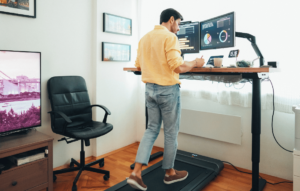We live in a world where sitting has become the norm. Whether it’s at a desk, on the couch, in front of a screen, or behind the wheel, hours slip away while we remain seated. What many don’t realize is that this seemingly harmless activity is quietly wreaking havoc on our health. In fact, sitting has become so detrimental that experts now compare its effects to smoking – yeah, it’s that serious.
Prolonged sitting is linked to a range of health issues, from cardiovascular problems and diabetes to musculoskeletal damage and even mental health decline. The good news? The solution doesn’t require a massive overhaul of your daily routine. By making a few simple changes, you can protect yourself from the silent dangers of sitting and reclaim your well-being. In this blog, we’ll explore why sitting kills and, more importantly, the easy steps you can take to stay healthy.
The Physical Toll of Sitting
Sitting for extended periods is simply not what the human body was designed for. Over time, this sedentary behavior can lead to serious health consequences, particularly for men who already face some unique health challenges. Let’s break down the physical toll:

Heart Health
One of the most alarming effects of prolonged sitting is its impact on the heart. Studies have shown that sitting for more than 8 hours a day can increase your risk of developing heart disease by up to 34%. When you sit, your body’s ability to break down fat slows, and blood flow is reduced, which can lead to high blood pressure, increased cholesterol, and even cardiovascular disease.
Weight Gain and Diabetes
Prolonged sitting can also wreak havoc on your metabolism. The longer you sit, the less your muscles engage, meaning fewer calories are burned. This leads to weight gain, particularly around the midsection, where men are more prone to store fat. Even worse, this type of weight gain can lead to insulin resistance and type 2 diabetes, a disease that’s becoming increasingly common among men with sedentary lifestyles.
Spine and Posture Problems
Have you ever noticed your posture after a long day at the desk? Sitting for extended periods promotes slouching, which leads to spinal misalignment and chronic back pain. The compression on the spine from sitting also increases your risk of disc degeneration and other musculoskeletal issues. Additionally, sitting weakens your glutes and tightens your hip flexors, contributing to imbalances that affect your overall mobility.
Mental Health and Cognitive Decline
It’s not just your body that suffers from too much sitting – your mind does too. Physical inactivity has been linked to a range of mental health issues, including anxiety, depression, and cognitive decline.
Mental Health Struggles
The psychological effects of a sedentary lifestyle can be profound. Physical activity stimulates the release of endorphins, which help boost mood and reduce stress. When you spend most of your day sitting, these mood-boosting chemicals are limited, which can lead to feelings of lethargy, anxiety, and even depression.
Reduced Productivity and Focus
In addition to acute mental health concerns, sitting too much can also affect cognitive performance. Blood flow to the brain decreases when we sit for long periods, leading to brain fog and difficulty concentrating. If you’ve ever felt sluggish or unmotivated after sitting at your desk for hours, it’s because your brain isn’t getting the stimulation it needs. Movement helps to oxygenate the brain and improve focus, making you more productive.
Increased Risk of Early Death
Perhaps the most concerning risk associated with sitting is its link to a shorter lifespan. Research shows that prolonged sitting is linked to a higher risk of early death – even for people who exercise regularly.
The Mortality Link
A study published in the American Journal of Preventive Medicine found that every hour of sitting shortens your lifespan by approximately 22 minutes. Over the course of a lifetime, this can add up to years lost due to the sedentary nature of modern life. What’s more, the effects are cumulative – meaning even short bursts of inactivity throughout the day can have long-term consequences.
Exercise Isn’t Enough
Even if you work out regularly, prolonged sitting still carries risks. A 30-minute workout can’t fully offset 8 hours of sitting. Studies show that the detrimental effects of sitting remain, regardless of how much time you spend in the gym. This means consistent movement throughout the day is essential to your health.
How to Counteract the Dangers of Sitting
The good news is, it’s relatively easy to counteract the negative effects of sitting. Implementing small changes throughout your day can lead to huge improvements in your overall health.

Move Every 30 Minutes
One of the simplest ways to mitigate the dangers of sitting is to incorporate frequent movement into your day. Try setting a timer to stand up and walk around every 30 minutes. Even just a 2-minute walk around the office or at home can help improve circulation and counteract the harmful effects of sitting. If possible, consider investing in a standing desk, which allows you to alternate between sitting and standing throughout the day.
Strengthen Key Muscles
Sitting leads to muscle imbalances that affect posture, mobility, and overall strength. To combat this, focus on strengthening the muscles most affected by prolonged sitting – namely, your core, glutes, and back. Exercises like squats, lunges, planks, and deadlifts are excellent ways to target these areas. By strengthening your body, you’ll be better equipped to handle the occasional bouts of sitting without damaging your health.
Stretch and Improve Mobility
Sitting leads to tight hip flexors, hamstrings, and lower back pain, so regular stretching is essential. Incorporate hip flexor stretches, hamstring stretches, and spinal mobility exercises into your daily routine to improve flexibility and reduce discomfort. A simple stretching routine you can do at your desk includes standing quad stretches, seated hamstring stretches, and torso twists.
Optimize Your Workspace
Ergonomics plays a crucial role in maintaining good posture and reducing the risk of sitting-related health issues. Ensure your desk setup supports your body. Your chair should provide lumbar support, your feet should rest flat on the ground, and your screen should be at eye level to avoid neck strain. If you use a laptop, consider getting a separate keyboard and mouse to allow for a more ergonomic setup.
Incorporating Movement in Your Routines
In addition to breaking up long periods of sitting, incorporating active habits throughout your day can make a huge difference. Consider walking, pacing, or even just standing while taking phone calls, using the stairs instead of the elevator, or walking to a colleague’s desk instead of sending an email. You can even try “walking meetings” to discuss ideas while getting some fresh air. If you work from home, set a goal to complete small household chores between tasks, like loading the dishwasher or folding laundry – anything that gets you moving counts.
Another easy way to stay active is by using fitness trackers or apps that remind you to move. Many of these devices offer subtle nudges, like vibrating alerts, to encourage you to stand up or take a few steps throughout the day. These small changes may seem insignificant, but they add up quickly, helping to keep your muscles engaged and your metabolism active.
Conclusion
Sitting might seem harmless, but it’s actually sabotaging your health in ways you probably don’t realize. From cardiovascular disease and weight gain to mental health decline and shortened lifespans, the dangers are real – but they’re also preventable. By incorporating simple habits like standing up regularly, strength
decline and shortened lifespans, the dangers are real – but they’re also preventable. By incorporating simple habits like standing up regularly, strength
ening your muscles, and improving your posture, you can protect yourself from the harmful effects of sitting.
Don’t wait until you feel the consequences – take action now. Start moving, strengthen your body, and make your workspace a healthier place. Your future self will thank you.








